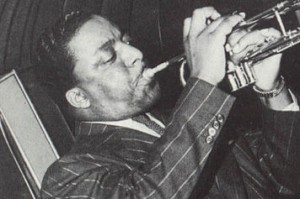
Erskine Hawkins was a jazz trumpeter and bandleader from Birmingham, Alabama. He earned the nickname as “the Twentieth Century’s Gabriel” through his flamboyant playing style and ability to hit high notes. As a boy, Hawkins first learned to play drums, trombone & saxophone before settling on trumpet at age 13. His most recognizable hit is the 1939 tune Tuxedo Junction. The song title refers to a streetcar intersection of the same name on the Ensley-Fairfield line in Birmingham that was a center of nightlife for African Americans from the 1920s through the 1950s. Hawkins would often play music in the nearby park, and the sounds he heard coming from the juke joints and ballrooms at this location served as an early musical influence.
While attending Alabama State Teacher’s College, he played with and eventually led the Bama State Collegians which was regarded as the most talented of three bands playing on campus. While touring in New York in 1934, most of the Collegians decided to stay in New York, where they eventually formed the Erskine Hawkins Orchestra. The band played at the Apollo Theater as well as at school dances and local venues. One night at the Apollo, Louis Armstrong, whose records had been an early influence on Hawkins, surprised Hawkins backstage. Later, when Hawkins went on to play the Savoy Ballroom, Armstrong would invariably join him on stage.
While playing at the Savoy Ballroom, Hawkins’ Orchestra would alternate with Chick Webb’s Band, so that dancers had an uninterrupted night of music — there was no DJed music in those days. Hawkins’ Orchestra eventually played several years as the Savoy House band and participated in “battles of the bands” with the likes of Glenn Miller, Duke Ellington & Lionel Hampton. Hawkins’ band remained popular throughout the 1930s and 40s, and his musicians, who genuinely enjoyed playing together, stuck together until 1953, when the band began to play as a smaller combo. Still the Hawkins big band played occasional reunion performances from time to time.
Erksine Hawkins three most famous hits were Tuxedo Junction, Tippin’ In and After Hours. Tuxedo Junction, which became a sort of anthem for WWII GIs, also serves as a great song for dancing the Shim Sham, a popular swing era jazz line dance. Indeed, Lindy Hop dance legend Frankie Manning who helped repopularize the Shim Sham among modern swing dancers included both Tuxedo Junction & Tippin’ In as selections on his “Really Swinging” compilation CD.
Some of my favorite Erskine Hawkins swing dance tunes are:
- Gin Mill Special
- Miss Hallelujah Brown
- Holiday for Swing
- Rockin’ Rollers’ Jubilee
- Swingin’ on Lennox Avenue
- Tuxedo Junction
- Uptown Shuffle
You can find most of these tunes on these two albums:
